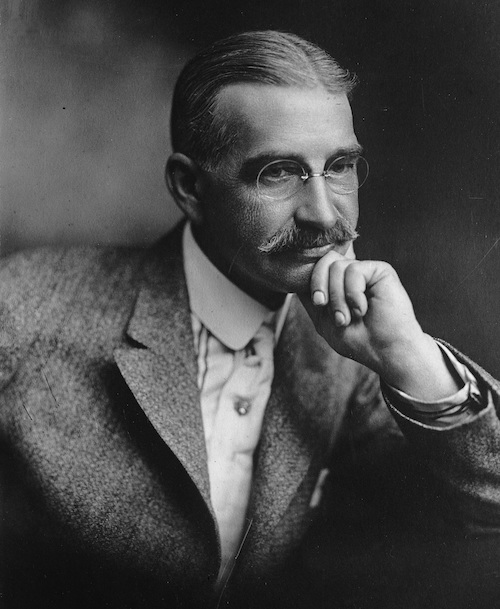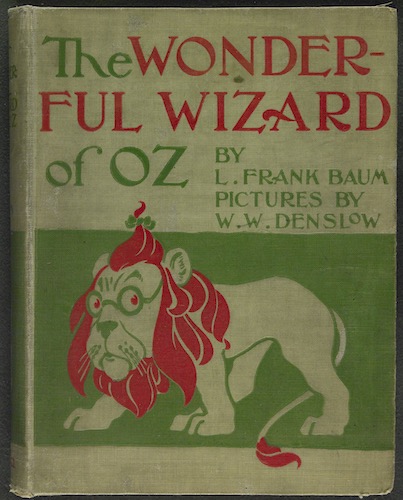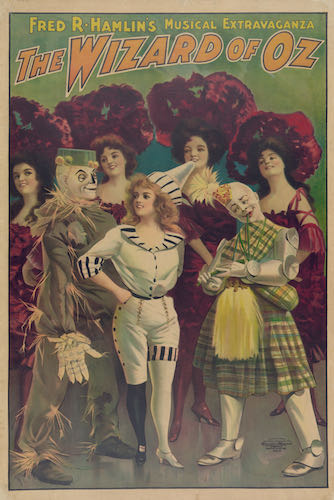Communiqué
The man behind one of the most beloved and enduring American classics, “The Wonderful Wizard of Oz,” on AMERICAN EXPERIENCE – Nov. 23 at 9 pm
< < Back toAmerican Experience: American Oz
Thursday, November 23 at 9 pm
Film Explores the Life and Times of L. Frank Baum, Creator of the Beloved The Wonderful Wizard of Oz
American Experience presents American Oz, a documentary that explores the life and times of author L. Frank Baum, the creator of one of the most beloved, enduring and classic American narratives. By 1900, when The Wonderful Wizard of Oz was published, Baum was 44 years old and had spent much of his life in restless pursuit of success. With mixed results he dove into a string of jobs — chicken breeder, actor, marketer of petroleum products, shopkeeper, newspaperman and traveling salesman — but continued to reinvent himself, reflecting a uniquely American brand of confidence, imagination and innovation. During his travels to the Great Plains and on to Chicago during the American frontier’s final days, he witnessed a nation coming to terms with the economic uncertainty of the Gilded Age. But he never lost his childlike sense of wonder and eventually crafted his observations into a magical tale of survival, adventure and self-discovery, reinterpreted through the generations in films, books and musicals. Written, directed and produced by Randall MacLowry and Tracy Heather Strain and executive produced by Cameo George.

“Baum is a distinctly American character and the story of his remarkable life offers a fascinating window into the last days of the frontier and the birth of the modern era at the turn of the 20th century,” said Cameo George, American Experience Executive Producer. “He embodies those quintessential American traits of optimism and drive and managed to turn what he witnessed into a story that never seems to get old. It continues to be reinvented for new audiences who identify so powerfully with Dorothy, her band of lovable outcasts, and the longing for home.”
Featuring interviews with biographer Evan Schwartz, film historian Jeanine Basinger, Wicked author Gregory Maguire, and historian Philip Deloria, among many others, American Oz shows how L. Frank Baum wove together scraps and shards of his own experiences into an enduring work of the imagination. As a young husband and father, Baum was continually struggling to support his growing family. His quest to find his true calling led him through a dozen enterprises; some were abandoned for the next big thing and others failed. But each provided Baum with fodder that could be transformed in his writing.
The hopelessness of economic despair, the terrifying power of a cyclone and the universal longing to return home — all of these elements came from Baum’s own life. In South Dakota, where Baum moved the family in 1888, a historic drought destroyed the farming economy, forced the closure of his novelty store, and caused the newspaper he published to fail. The disillusioned farmers can be seen in the characters of Aunt Em and Uncle Henry, careworn and old before their time, and the decimated South Dakota landscape is echoed in the barren Kansas setting for The Wizard of Oz, where Dorothy could see “nothing but the great gray prairie on every side.”

He brought a theatrical flair and keen understanding of how to communicate with the American public to many of his more successful ventures, from marketing a special oil for horse-drawn carriages to publishing The Show Window, a trade journal about shop window displays. “Frank Baum was a natural salesman,” said Evan Schwartz, author of Finding Oz. “He was always trying to connect with people, to please people. He could make up stories about anything. Whether it was chickens or cans of oil, Frank Baum had a story for it.”
While working on the road as a traveling salesman in the mid-1890s, Baum, now the father of four sons, found time to write more often. In late 1897, 41-year-old Baum published Mother Goose in Prose, inspired by the stories he had been inventing for his sons. His second book, Father Goose, His Book, was an unexpected success. When The Wonderful Wizard of Oz was published in 1900, it was a sensation, becoming the best-selling children’s book in America. The story of Dorothy, a self-reliant orphan girl transported from her dreary life on the farm to a strange and wonderful Oz resonated with both young and old readers. Pioneering a new kind of literature for children, Baum said in his introduction that his work was “a modernized fairy tale, in which the wonderment and joys are retained and the heartaches and nightmares are left out.” He spent the rest of his life expanding the Oz universe through musical versions, a multimedia traveling show, film productions and additional books. When he died just before his 63rd birthday on May 6, 1919, the 13th Oz book was on its way to the press and another manuscript had been completed.
The story of Dorothy, the Tin Man, the Scarecrow and the Lion has continued to enthrall children and adults and been reinvented every generation. It found its most enduring place in American culture at the end of the Great Depression when The Wizard of Oz, the MGM feature film starring Judy Garland, opened on August 25, 1939. CBS began annual broadcasts of the movie in 1959, and the shared national event became a cherished tradition, firmly establishing the story as an American icon. In 1975, The Wiz, featuring an all-Black

cast, opened on Broadway, followed by the feature film version in 1978, starring Diana Ross, Michael Jackson, Nipsey Russell, Lena Horne and Richard Pryor. 1995 saw the publication of Gregory Maguire’s Wicked: The Life and Times of the Wicked Witch of the West, which became the basis for the smash-hit Broadway musical version of the same name. The play opened in 2003, and in 2017 became the second-highest-grossing musical, trailing only behind Lion King. In February 2021, a new feature film production of The Wizard of Oz was announced, as well as a feature film version of Wicked.
As Harvard University scholar Philip Deloria sums up in the film: “Who would’ve thought that a failed entrepreneur would write a little story, which would have repercussions and reverberations across the whole course of the 20th century and into the future?”
| Written and Directed by
Produced by
|
TRACY HEATHER STRAIN &
RANDALL MACLOWRY REBECCA TAYLOR RANDALL MACLOWRY TRACY HEATHER STRAIN |
| Edited by | CHAD ERVIN |
American Experience is a production of GBH Boston
| Executive Producer | CAMEO GEORGE |

